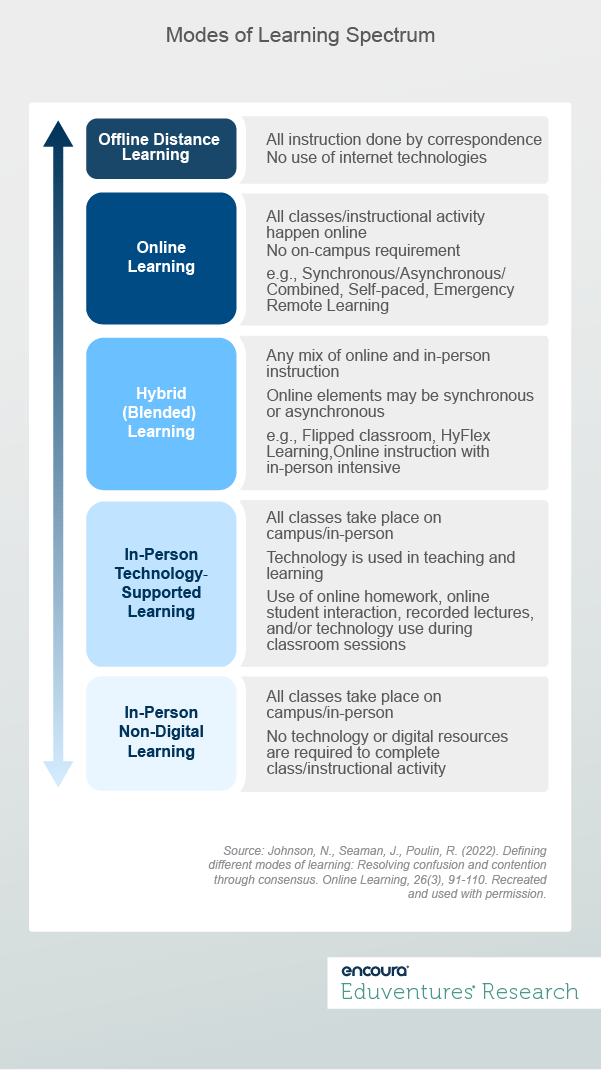According to Gallup, more than half of U.S. employees with remote-capable jobs now have a hybrid work situation, and fully remote work is more common than on-site for these jobs. These workplace trends are comparable to trends in hybrid and online learning.
As we discussed in a previous post, new data from CHLOE 8 supports the promise of hybrid modality, but hybrid supply and demand are mismatched because of complexity and challenges. While adult and graduate prospects continue to show a preference for hybrid learning, recent data also indicates a shift in student preference toward fully online programs.
This raises the question of whether online learning is genuinely preferred or if institutions are failing to promote hybrid learning effectively?
Adult Prospects Shifting Away from Hybrid Learning
Chief online officers (COOs)—college and university leaders that oversee online programs—are particularly bullish on hybrid learning, according to data from CHLOE 7 (Changing Landscape of Online Education: Tracking Online Learning from Mainstream Acceptance to Universal Adoption). This study shows chief online officers expect dramatic shifts toward hybrid modality across traditional undergraduates, adult undergraduates, and graduate students by 2025.
Enrollment data from Fall 2021 (IPEDS) shows that 16% of total graduate enrollment had “some distance education” (the best proxy for hybrid enrollment) while 32% of total undergraduate enrollment had “some distance enrollment.” Hybrid enrollment grew by 42% across both levels between 2012 and 2019 and continued to grow between 2019 and 2021 (+44%). The pandemic has accelerated hybrid enrollment and supports COOs’ predictions of a hybrid future.
New data from CHLOE 8 (Changing Landscape of Online Education: Student Demand Moves Higher Ed Toward a Multi-Modal Future) also supports expected growth. This year however, COOs reported the stronger enrollment growth across traditional undergraduate, adult undergraduate, and graduate for fully online programs compared to hybrid programs between Fall 2021 and Fall 2022.
While hybrid modality preference remains robust for adult student populations, we have seen a new trend emerge across the pandemic: a shift toward fully online programs. Figure 1 shows the change in modality preference (fully on-campus, hybrid, and fully online) for traditional undergraduate, adult undergraduate, and graduate prospects from 2019 to 2022.

Across these three populations, hybrid preference has decreased between 2019 and 2022 (by a range of -2% to -10%). At the same time, both adult undergraduate and graduate prospects have increased preference for fully online learning (by +9% and +7%, respectively). But this shift in preference has not come at the expense of fully on-campus, but exclusively at the expense of the hybrid learning preference.
Even with these downward trends, hybrid modality remains the most preferred option among adult populations (55% of adult undergraduate prospects and 61% of graduate prospects). While we previously covered some of the challenges that hybrid learning faces, what could explain this shift in preference?
Hybrid Confusion
We suspect the variability of hybrid learning is not well understood by prospective students due to the wide range of terms used. These run the gamut from academic descriptions to marketing jargon. Programs can be “hybrid,” “HyFlex,” “remote,” “blended,” with required “campus immersions,” “intensives,” “residencies,” or “experiences.” This does not even cover asynchronous versus synchronous online learning (newly covered in CHLOE 8).
While we hypothesize that prospective students may find the hybrid gray area confusing, researchers have developed a spectrum to categorize different modes of learning (Figure 2). This classification system includes offline distance, online, hybrid (blended), in-person technology supported, and in-person non-digital learning.

As institutions grapple with post-pandemic student expectations, this spectrum can be a useful tool to help decide how programs should be designed and delivered. With more clarity across the industry, prospects of all types should be better able to make informed decisions about hybrid modality instead of guessing what it could mean and potentially opting for the simplicity of fully online learning.
The Bottom Line
We anticipate that all prospective students will come to expect some form of online learning or support in the coming years—even those who prefer on-campus. While COOs predict a hybrid future and have seen enrollment growth in hybrid enrollment, preference for the modality has softened in favor of fully online.
Institutions can do more to meet the demand for hybrid preference by providing clarity and showing the value of coming to campus. Hybrid students want on campus experiences they can’t get remotely—this could include building relationships with fellow students and faculty, hands-on skills building, interactive group-work, or special guest lectures, to name a few.
Institutions must think innovatively about how best to serve and support all students, no matter their preferred modality. This is especially important as modality preferences continue to shift over time.
Never Miss Your Wake-Up Call
Learn more about our team of expert research analysts here.
Eduventures Senior Analyst at Encoura
Contact
The eighth installment of the Changing Landscape of Online Education (CHLOE) report, produced by Quality Matters™ and Eduventures®, offers an overview of the current state of online learning in higher education as well as insights into its future development. The report was compiled by surveying chief online officers (COOs) — the professionals best situated to assess the current state of this ever-developing field — at U.S. two- and four-year colleges and universities.

